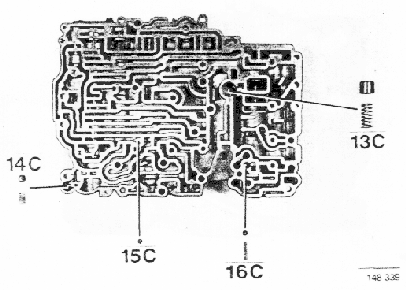960/V90 kraak in automaat bij het schakelen tussen 1&2e versnelling_hopelijk is het dit:
960/V90 kraak in automaat bij het schakelen tussen 1&2e versnelling_hopelijk is het dit:
Heren ik heb de volgende vraag:
Bij het laten uitrollen/afremmen van 40 kmh naar stilstand hoor ik een kraak onder de auto uit komen. Nu is er een post geweest onlangs en daarvan dacht men dat het bovenste veerpoot lagerrubber versleten kon zijn. Nu zit hier bij inveren speling op bij ons rechtsvoor. Echter ben ik bang dat het in de automaat zit. Als ik in de N langzaam uitrol heb ik het idee dat de kraak er niet is. Ik vermoed hierdoor dat het in het terugschakelen van de bak is. Ook heb ik sinds gisteren bij wegrijden een keer een twijfelende automaat gehad die van 2 weer terug naar 1 schakelde en dan weer terug naar zijn 2 en dan door naar de 3. Heel raar gevoel is dat. Ook ruik ik een branderige geur als ik achter de auto sta...
Wie o wie denkt dat ie weet wat het kan zijn?
Bvd Thijs
update, ik vond dit:
AW-70/71 Hard Shifts.
Symptoms. The AW71 in my '86 740 used to shift very hard from 1st to 2nd gear. This shift is the first shift and it usually happens at about 20 km/h (depends on how hard you accelerate). It felt almost like getting rear-ended. [Editor] Hard 2-3 shifts are also symptomatic.
Try the Easy Things First. [David Hunter] A flush may cure the shift problem. On my 88 740 at around 240K I encountered delayed shifting from 1st to 2nd and 2nd to 3rd. Also had OD problems. After checking the common causes such as kickdown cable, OD relay and solonoid I elected to do a flush with Mobil 1 synthetic. The results were immediate and dramatic: all problems went away. In addition, check the kick down cable adjustment regarding those hard shifts. You may be pleasantly surprised.
Worn Valve Ball. [Toni Arte] The real cause for this problem is a worn valve ball in the transmission valve body. This ball is the 15C in the picture. This is a picture of the lower valve body. A replacement valve ball is available, you can order it from your local Volvo dealer. The part number is 1377746-1 (small blue valve ball). [Tip from Herman] You may need gasket kit p/n 271292. Before you do the job, buy the OEM manual: the manual number is TP 31642/1. The manual is for AW70/70L,AW71/71L, and AW72L. The L means lockup, check the tag on the tranny before you buy your gasket kit. For detailed instructions, see Brad Wightman's excellent illustrated writeup.

In my case the 5.5 mm valve ball was worn to about 2 mm size. Note that the valve body can be accessed through the oil pan, so it's not necessary to drop the transmission. A competent transmission shop should be able to change this ball. In my case the cost was about $100, this includes two hours of labour, new gaskets and fluid.
[More from Herman] Great care needs to be taken upon disassembly however it's an easy job with some potential of going very wrong. I tried the wrong way first. I disassembled enthusiastically and lost one ball of about 15, dropped a retaining pin and then wasted 2 hours scratching my head and agonising about the lost ball. A friend had a dead AW71 and let me take it apart for reference. This time I followed the manual and compared the two valve bodies. The job was dead simple once I went about it the right way. GET THE MANUAL and follow the steps that get you to opening the valve body up. The manual says nothing about the balls so you need to locate them and note ON PAPER where they go. There are a lot of balls and things that can go flying and falling into your parts cleaner. Following the steps in the manual however, takes away that risk. As in the photo on that page, my ball was worn to half the size of the new one and was blown out from its seat and had gone somewhere else. I think I replaced about 5 maybe 6 quarts of fluid (I use only AMSOIL). Make sure you have a lot of good quality paper towel (cloth fibre won't break down should it get into the gubbins) for the job and a large clean well-lit bench surface.
[Tip from Gary De Francesco] Rough 1 - 2 shifts are a possible sign of a worn rubber ball in the valve body that regulates how fast the various clutches and brakes are applied. As the ball wears, the fluid flow rates in some of these regulating passages can increase which will cause the various hydraulic actuators to engage faster. This will feel like a sudden and rough engagement. On the one hand, with fast engagement, there is little chance for the clutches and brakes to slip. This means less wear, and hence a longer lasting tranny. On the other hand, these fast engagements result in a bit of jarring to the occupants of the car. The solution is to have the valve body serviced. This can usually be done without removing the tranny. So you have to decide. Can you live with a little jarring, or do you want to spend some money and see if it can be smoothed out.


